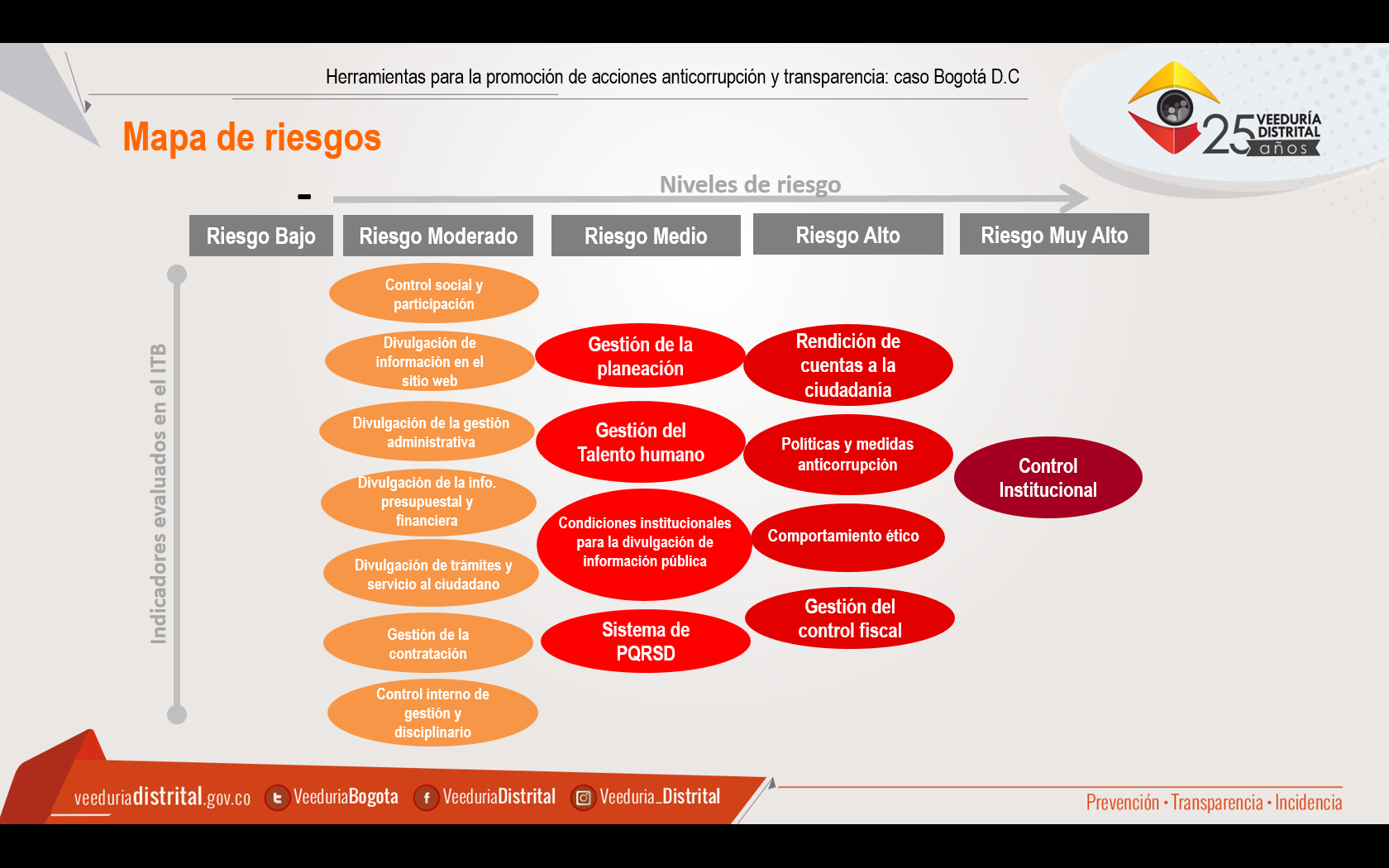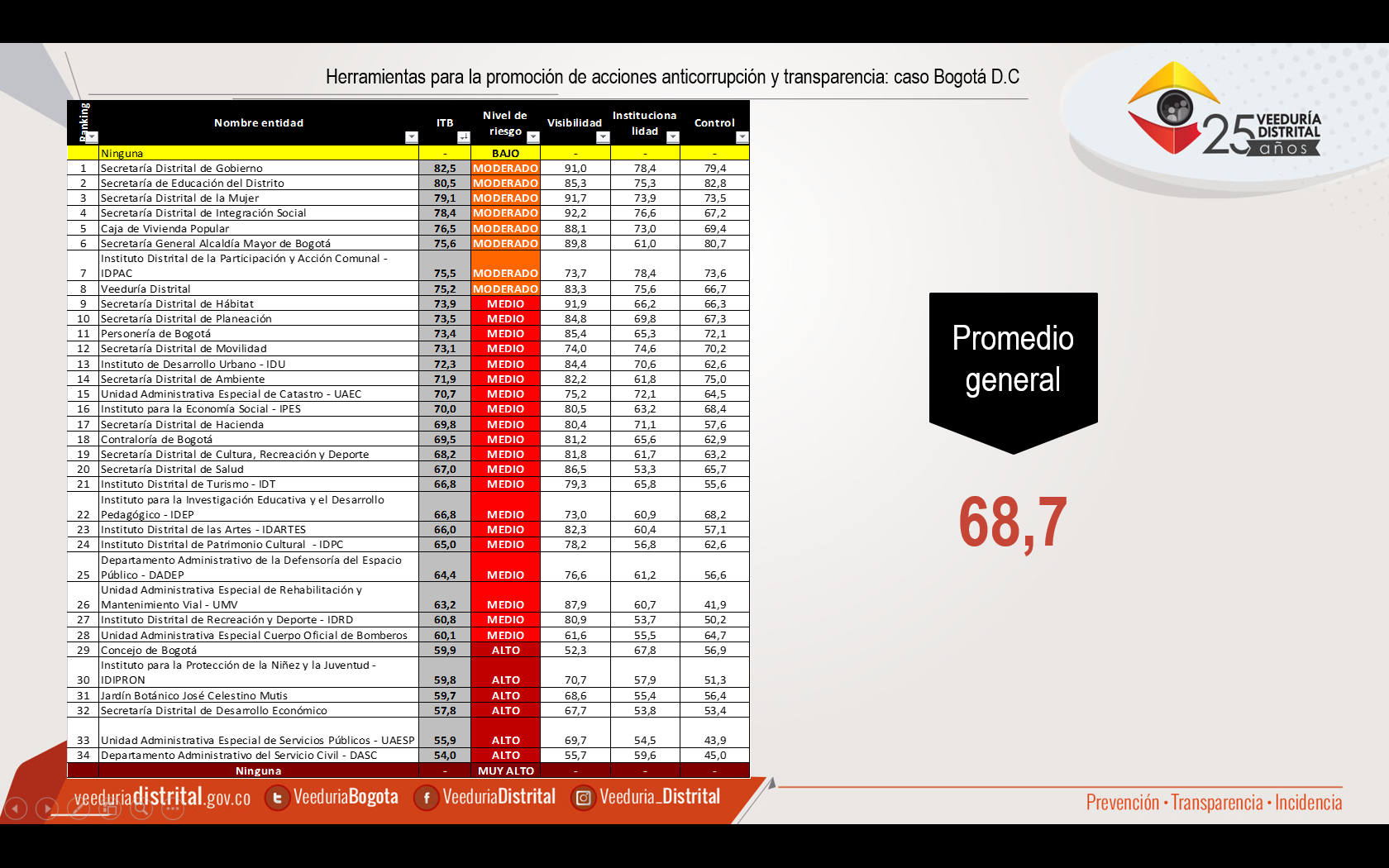Bogota Transparency Index
Description
The Veeduría Distrital of Bogota is an autonomous preventive control agency that analyses, investigates and seeks to prevent administrative inefficiencies and corruption risks in the City´s governmental agencies. The scope of work of this agency merges an oversight function with the capacities of an ombudsman. Bogotá’s Transparency Index (ITB) is a tool lead by the Veeduria Distrital since 2016 in alliance with the private sector and civil society, which identifies flaws in institutional practices of public authorities that enable corruption risks, and measures such risks but also identifies good practices and actions that will tackle such risks.
The Index aims to identify scenarios and practices that generate corruption risks and failures in the institutional design of public agencies in Bogotá and to undertake improvement actions to mitigate such risks. The ITB focuses on three risk factors: Visibility: This factor consists on four indicators that evaluate the guidelines, procedures and mechanisms for handling public information, as well as the effective dissemination of information in administrative, budgetary and financial management as well as public service delivery. Institutional development: This factor evaluates the development and compliance of legal standards related to five indicators: human resources, ethics, planning and oversight, procurement processes and anti-corruption policies. Sanctions and control: This factor measures the institutional capacities of each agency to promote, facilitate and generate sanctions and controls on its management in five indicators, as well as opening citizen participation. The ITB is the first measurement tool to verify the City’s compliance of the SDGs and is an action that affirms Bogotá’s commitment to comply with SDG 16.5: Substantially reduce corruption and bribery in all their forms. The Index’s evaluation looks for mechanisms and individuals responsible for the implementation of ethical and organizational guidelines, the involvement of relevant stakeholders, follow-up actions and elements on prevention and mitigation of bribery. Additionally, the Index acknowledges the importance of information and the guarantee free access of all public information in alignment with SDG 16.10: Ensure public access to information and protect fundamental freedoms, in accordance with national legislation and international agreements. Among the topics comprised in the evaluation is the implementation of open data standards for institutional documents, the implementation of instruments and procedures for filling documentation and advertisement of information on human resources, budgetary management and internal auditing. <br />
How to create and promote an independent, objective, and inclusive evaluation was one of the challenges faced by the Veeduria Distrital. In this sense, this tool is a clear example of innovative co-creation between the public sector and civil society incorporating the independent point of view of the citizen. A second challenge was to determine the usefulness of the outcome of the evaluation. For the specific case of Bogotá, the results obtained allowed us to identify good practices and to generate exchanges of those practices among different agencies. Furthermore, these exchanges allowed the generation of new ideas in order to promote transparency and improve the provision of services to citizens. The ITB seeks to work under a collaborative approach to resolve the identified failures and mitigate corruption risks. <br />
A final challenge was finding the measurement’s benefits in terms of the City’s policies. In this regard, the ITB adds public value to the work of public authorities in the fight against corruption by incorporating the citizen’s perspective in the improvement of institutional designs for the promotion of transparency. This methodological proposal is innovative because it identifies and assesses corruption risks aside from traditional methods of study and serves as a tool for citizens to conduct social oversight on the City’s administration
The Veeduría Distrital started this process in 2016 with an agreement with TI Chapter Colombia for the construction of a conceptual and methodological framework to measure risks of corruption in Bogota´s public agencies.
The conceptual and methodological design of the ITB was developed by TI Chapter Colombia, and throughout 2016, information forms and tools for data gathering were designed. The Veeduría Distrital and TI Chapter Colombia built the conceptual and methodological framework in close collaboration. Later on, the Chamber of Commerce of Bogotá CCB and the Foundation for Progress of the Capital Region Probogotá, joined forces through an alliance to promote a transparent public administration for the City. A product of this alliance is the ITB and its findings.
During the initial stages of implementation, Transparencia por Colombia created additional protocols for the verification and evaluation of requested information for the measurement. In the mid-2016 period, both the Veeduria Distrital and Transparencia por Colombia reviewed and adjusted the Index’s indicators, in order to determine the final variables and sub-variables of the measurement.
Overall, this project was comprised of five implementation phases:
1. Preparation (July 2017-August 2017): The Index’s concept and methodology was finalized and each agency named a representative (spokesperson) in charge of communicating with Transparencia por Colombia to present the required information to evaluate in the Index.
2. Data collection (August 2017): By direct agency’s verification of the web page, secondary sources and information gathered through an online form. 90% of the information used for the evaluation was provided by the agency in this phase.
3. Clearance and evaluation (August-November 2017): TI Chapter Colombia validated the information presented and began the evaluation process for each indicator.
4. Preliminary findings and publication of results (December 2017): TI Chapter Colombia extracted the first preliminary scores, and presented them to the evaluated agencies for a chance at correcting or adding information.
5. After this period, TI Chapter Colombia conducted the final evaluation and presented final scores (January-April 2018). Those scores were presented publically, made available to all agencies and public in general.
The alliance formed by the Veeduría Distrital, TI Chapter Colombia, the Chamber of Commerce of Bogotá and ProBogotá has set up a follow-up mechanism to the results of the ITB through a strategy of accompaniment for the 34 public entities who participated in the measurement. This strategy seeks to train and monitor the work plans that agencies implement to adopt corrective and short-term improvement actions. In this sense, the Veeduría Distrital held one-on-one meetings in 2018 with the evaluated agencies as well as six workshops on access to information, public integrity, human resources, public accountability and internal management with all evaluated agencies as well as other relevant actors. During these workshops, TI Chapter Colombia presented the overall methodology of the measurement in order to clarify certain aspects. In addition, all workshops developed each topic practically and highlighted a couple of high-scored practices in the measurement.
A result of the Index was an average risk score of 68,7 points for the City, locating it at a medium risk of corruption. For this first version of the ITB, the lowest score was 54 points for Departamento Administrativo del Servicio Civil Distrital and the highest for Secretaria Distrital de Gobierno with 82,5 points. Eight agencies scored a moderate risk of corruption, 20 of them with a medium risk and the remaining six agencies scored a high risk of corruption. Additionally, the Index presented a scorecard for each evaluated agency with the total score of each of the 14 indicators and a thorough explanation of the evaluation by sub-indicators and variables, as well as the individual level of risk. The Index also results on corruption risk maps for each agency and administrative sector, and for the City as a whole. These maps identify which areas of management have greater risks that require immediate improvement actions within each agency or sector. This implies that, based on the results obtained, work plans have been established to implement improvement actions and for the recognition and replication of good practices at the local level.
Furthermore, the Index positioned the issues of transparency in the public agenda of the City. The results allowed City authorities to begin to understand the subject as an underlining policy issue to all administrative processes and management of public agencies. In addition, its application delivered relevant inputs for the formulation of Bogota´s Public Policy of Transparency, Integrity and Non-Tolerance with Corruption, in order to establish goals and concrete actions in the long term.
Finally, the tool´s methodology takes into account the institutional design established by law for every agency in the City, but also allows the evaluation of good practices in the City’s agencies. The second application of the ITB will evidence the institutional changes in order to minimize the corruption risk identify in the first version of the Index.
The current political climate in Bogotá and the country enabled the ITB to become more relevant. As corruption becomes a more latent issue in Colombia, to have a tool that allows concrete actions to eradicate this phenomenon became a priority for Bogotá’s public administration. Another factor that benefited this exercise was that the four actors mentioned above joined in an alliance to promote a transparent public management of the City, which allowed a more robust process of implementation of the Index. Additionally, the participation of external actors form the private sector and civil society allowed the ITB to become an independent and impartial evaluation.
Essentially, the ITB allowed the agencies to implement new actions and procedures on anti-corruption and transparency aside from actions set out in existing laws and regulations. The Index allowed a better understanding of the implications of conducts such as conflicts of interests and bribery, which enabled the creation of specialized teams inside the agencies to tackle such problems. Moreover, the evaluated agencies have strengthened their public integrity policies and procedures and consolidated a detailed approach of their own accountability based on the Index’s results.
The ITB was based on a previous methodology used by Transparencia por Colombia, the national chapter of Transparency International, to evaluate national and municipal agencies and institutions. The ITEP or “Indice de Transparencia de las Entidades Públicas” has been used since 2002 to create data for all national agencies. Even though there have been previous measurements nationally and some preliminary studies on the matter for the case of Bogotá, the alliance that initiated the ITB made some methodological adjustments to the overall design of the tool, to allow an accurate reading of how anti-corruption issues are raised in all public agencies of the City.
The conceptual and methodological design of the Index is easily transferrable in other Latin-American large cities that are interested in measuring transparency standards and identifying corruption risks based on institutional designs. The core of the tool is determining a baseline with objective data on the implementation of anti-corruption measures that can define future strategies oriented at promoting transparency, public integrity and citizen participation as public values to uphold and comply in all aspects of public management.
In addition, the ITB’s application can be replicated by City’s districts in order to comprise a wider approach of all local authorities that work at the central level and the district level.
The Veeduria Distrital’s primary task for the City is to create and implement clear guidelines for articulated preventive actions of the government, citizens, public agencies and other stakeholders. This objective is achieved by offering new and innovate opportunities to promote probity in local servants’ actions and improving public management of the particular issue of corruption. The Veeduria Distrital has pushed for a better understanding of this problematic in the City and by promoting tools that effectively tackle the phenomenon. <br />
<br />
Several factors have to be taken into consideration to tackle corruption. The complexity of corruption has called on Bogota’s public administration to determine its impact on the development of the City and its multidimensionality. It also calls for the involvement not only of the district’s public administration, but also civil society actors, trade unions, academia and citizens, among others. In this regard, it was necessary to have a long-term tool, with a prospective vision, that focused on addressing corruption by looking at its initiating factors. In line with the Veeduría Distrial mission, the ITB does provide such tool, and benefits from addressing it from a preventing vision. By determining how corruption risks occur, the City is able to prevent them and manage them properly. Additionally, it is the first public-private initiative where civil society and the private sector are actively involved in City matters.<br />
<br />
It is the first time that Bogota measures its risk of corruption in public management through an Index, and as such is an instrument of a strategic nature that allows articulating the projects and actions of Bogota’s public agencies with the SDGs, particularly with SDG 16. The goal of this exercise is to create a baseline that allows public agencies in the City to promote and define effective actions to eradicate corruption. Furthermore, the City will fulfill the benchmarks set for the 2016-2020 period, as one of the goals planned for the City is to improve by 5 points on the overall Index’s score. Furthermore, this exercise will be replicated within different administrations of Bogotá, to further bolster the idea of a city with more transparency and with zero tolerance for corruption. <br />
<br />
Finally, the results of the ITB raised the profile of the discussion of corruption in Bogotá, with the local administration taking notice of the importance of addressing this issues properly. The Index’s results were the first baseline foundation of the City’s Public Policy on Transparency, Integrity and No Tolerance for Corruption, Bogota’s first policy on this matter. The data and information extracted from the ITB has allowed the City to set up an action plan for the next 10 years comprised in this policy, with clear objectives, projects and actions that involved all agencies and institutions, as well as stakeholders from civil society and private sector.
Deliverables & Timeline
Resources mobilized
Partnership Progress
| Name | Description |
|---|
Feedback
Action Network


Timeline
Entity
SDGs
Region
- Latin America and the Caribbean
Geographical coverage
Photos


Website/More information
Countries

Contact Information
Jaime Torres-Melo, Mr.
